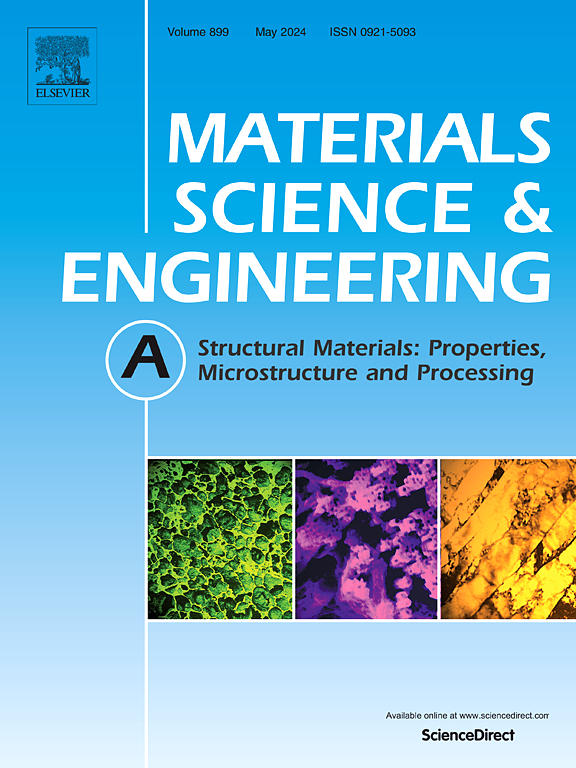Energy input effects on the microstructure and mechanical behavior of Ti–Nb alloy additivelymanufactured by electron beam melting
IF 6.1
2区 材料科学
Q1 MATERIALS SCIENCE, MULTIDISCIPLINARY
引用次数: 0
Abstract
The critical niobium content required to maintain the β phase in additively manufactured Ti–Nb alloys, preventing martensitic transformation, is still unclear. Our previous study showed that 42 wt% Nb was insufficient. Therefore, in this study, new pre-alloyed β-titanium alloys with high niobium percentage (56 wt%, Ti–56Nb) were successfully produced by Electron Beam Powder Bed Fusion (PBF-EB), and the effect of varying beam current (4 mA, 5 mA, and 7 mA) on microstructure and mechanical properties was studied. All processing regimes achieved proper fusion, with a uniform porosity distribution (∼0.3 %) and minimal niobium-enriched regions, attributed to powder heterogeneity. Beam current variations significantly affected melt pool dynamics, phase constitution, and heat distribution. Planar growth along layer boundaries and cellular structures within melt pools was observed, caused by high thermal gradients and high cooling rates. Texture analysis revealed that higher beam currents induced fiber-like textures due to zigzag beam movement and deep remelting, while 4 mA and 5 mA beam currents produced biaxial textures with minimal fiber contributions. TEM analysis indicated that higher energy input facilitated martensitic transformation, whereas lower energy enhanced β-phase stabilization. Mechanical testing identified the 4 mA regime as optimal, achieving the highest yield strength, favorable β-phase fraction, reduced elastic modulus, and enhanced wear resistance. This study demonstrates how varying beam energy inputs during PBF-EB printing can tailor the meso- and micro-scale structure and mechanical properties of Ti–56Nb alloys, providing valuable insights for optimizing densification, microstructure, texture, and mechanical performance in additive manufacturing applications.
能量输入对电子束熔化增材制备Ti-Nb合金显微组织和力学行为的影响
在增材制造的Ti-Nb合金中,维持β相、防止马氏体转变所需的临界铌含量尚不清楚。我们之前的研究表明,42 wt% Nb是不够的。因此,本研究采用电子束粉末床熔合(PBF-EB)法制备了高铌率(56 wt%, Ti-56Nb)的新型预合金β-钛合金,并研究了不同束流(4 mA, 5 mA和7 mA)对合金显微组织和力学性能的影响。所有的加工过程都实现了适当的融合,具有均匀的孔隙率分布(~ 0.3%)和最小的富铌区,这归因于粉末的非均匀性。束流变化显著影响熔池动力学、相构成和热分布。在熔池中观察到沿层边界和胞状结构的平面生长,这是由高热梯度和高冷却速率引起的。织构分析表明,较高的光束电流由于光束的锯齿状移动和深度重熔而产生了纤维状织构,而4 mA和5 mA的光束电流产生了双轴织构,纤维贡献最小。TEM分析表明,较高的能量输入促进了马氏体相变,而较低的能量输入促进了β相的稳定。力学测试结果表明,4ma的强度最高,β相分数较好,弹性模量降低,耐磨性增强。该研究展示了PBF-EB打印过程中不同的光束能量输入如何调整Ti-56Nb合金的中观和微观结构和机械性能,为优化增材制造应用中的致密化、微观结构、织构和机械性能提供了有价值的见解。
本文章由计算机程序翻译,如有差异,请以英文原文为准。
求助全文
约1分钟内获得全文
求助全文
来源期刊

Materials Science and Engineering: A
工程技术-材料科学:综合
CiteScore
11.50
自引率
15.60%
发文量
1811
审稿时长
31 days
期刊介绍:
Materials Science and Engineering A provides an international medium for the publication of theoretical and experimental studies related to the load-bearing capacity of materials as influenced by their basic properties, processing history, microstructure and operating environment. Appropriate submissions to Materials Science and Engineering A should include scientific and/or engineering factors which affect the microstructure - strength relationships of materials and report the changes to mechanical behavior.
 求助内容:
求助内容: 应助结果提醒方式:
应助结果提醒方式:


